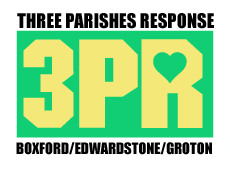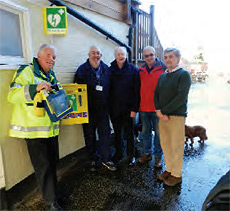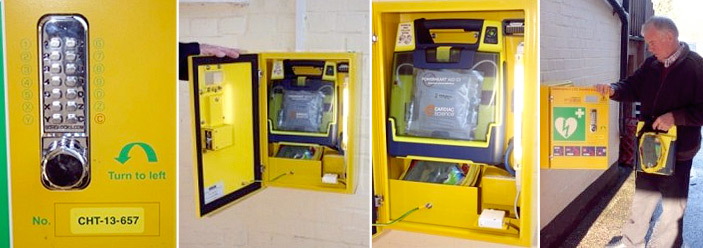COMMUNITY FIRST RESPONDERS
3PR - THE THREE PARISHES RESPONSE TEAM
BOXFORD / EDWARDSTONE / GROTON

OUR COMMUNITY PUBLIC ACCESS DEFIBRILLATOR
From December 2014 the Public Community Access
Defibrillator has been in use. Situated in the passageway in the Fleece
Hotel yard, it is located on the left hand side. It is illuminated at night and
there is a guide light on the Broad Street side of the archway directing
you to its location. Activation of the defibrillator is by calling 999 and
receiving the key code from them which will be C (clear) followed by a
three digit code and a final letter. 3PR (Three Parishes Response) will be
responsible for the upkeep of the cabinet. A public familiarisation
meeting was held in The Fleece on 9th December 2014 which was well
attended.
3PR are offering a demonstration of CPR (cardio pulmonary
resuscitation), recovery position and use of the defibrillator to any
organisation in the villages of Boxford, Edwardstone or Groton. A
telephone call to book a demonstration to Rich on 01787 210946 or Vic
on 01787 210504 would be welcome.
Boxford Parish Council funded the defibrillator. 3PR supplied the Box. John Norton, owner of the Fleece Hotel allowed the facility to be installed in his yard.


What is an Automated external defibrillator
An automated external defibrillator or AED is a portable electronic
device that automatically diagnoses the potentially life threatening
cardiac arrhythmias of ventricular fibrillation and ventricular tachycardia
in a patient, and is able to treat them through defibrillation, the
application of electrical therapy which stops the arrhythmia, allowing the
heart to re-establish an effective rhythm.
Simplicity of use
Unlike regular defibrillators, an automated external defibrillator requires
minimal training to use. It automatically diagnoses the heart rhythm and
determines if a shock is needed. Automatic models will administer the shock without the user's command. Semi-automatic models will tell the
user that a shock is needed, but the user must tell the machine to do so,
usually by pressing a button. In most circumstances, the user cannot
override a "no shock" advisory by an AED. Some AEDs may be used on
children - those under 55 lbs (25 kg) in weight or under age 8. If a
particular model of AED is approved for pediatric use, all that is required
is the use of more appropriate pads. Some organisations, such as the
American Heart Association, recommend that if pediatric AED pads are
not available, adult pads should be used to determine if the child is in a
shockable rhythm. There is insufficient evidence to suggest that a child,
in a shockable cardiac arrest, can be "hurt" by an adult defibrillation
energy setting.
Both Boxford AEDs have a set of Paediatric pads which can be quickly swapped for the adult set.
All AEDs use an electronic voice to prompt users through each step.
Because the user of an AED may be hearing impaired, many AEDs now
include visual prompts as well. Most units are designed for use by nonmedical
operators. Their ease of use has given rise to the notion of public
access defibrillation (PAD), which experts agree has the potential to be
the single greatest advance in the treatment of out-of-hospital cardiac
arrest since the invention of CPR.
Public Access Defibrillators (PAD) are very common in large stores and retail outlets these days, more are added each week. Members of staff are usually trained for their use. However, most of these are not available when these outlets close their trading hours hence the introduction of Community Public Access Defibrillators (CPAD) which are available 24/7 and deployed following an emergency call.